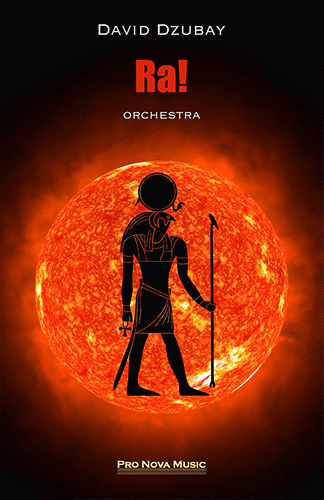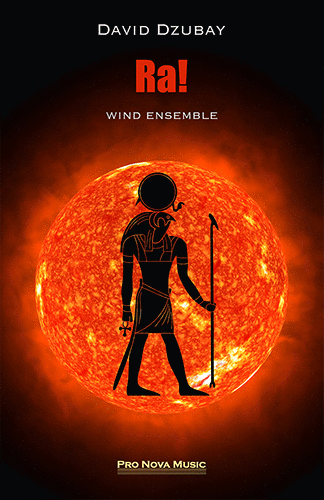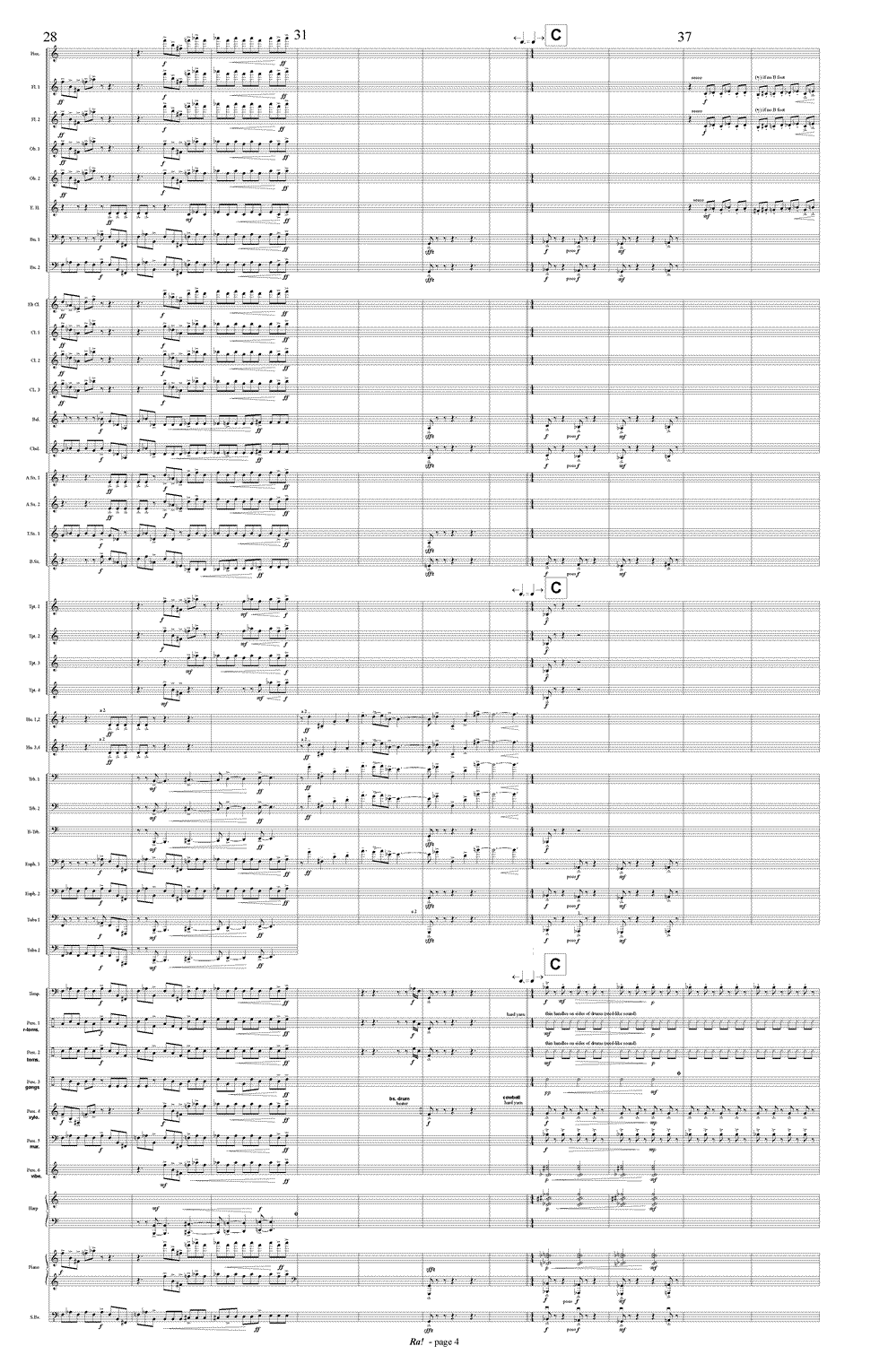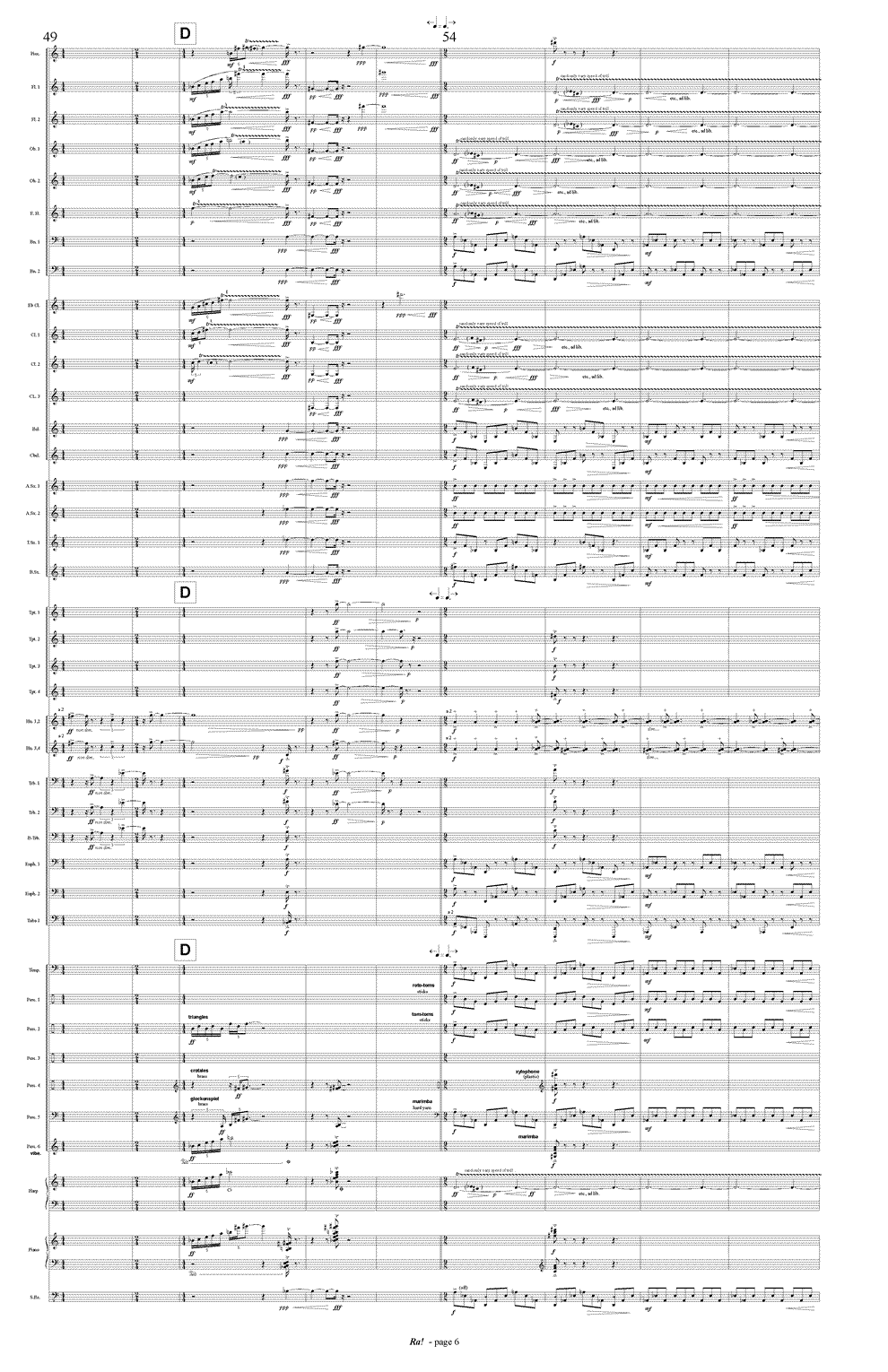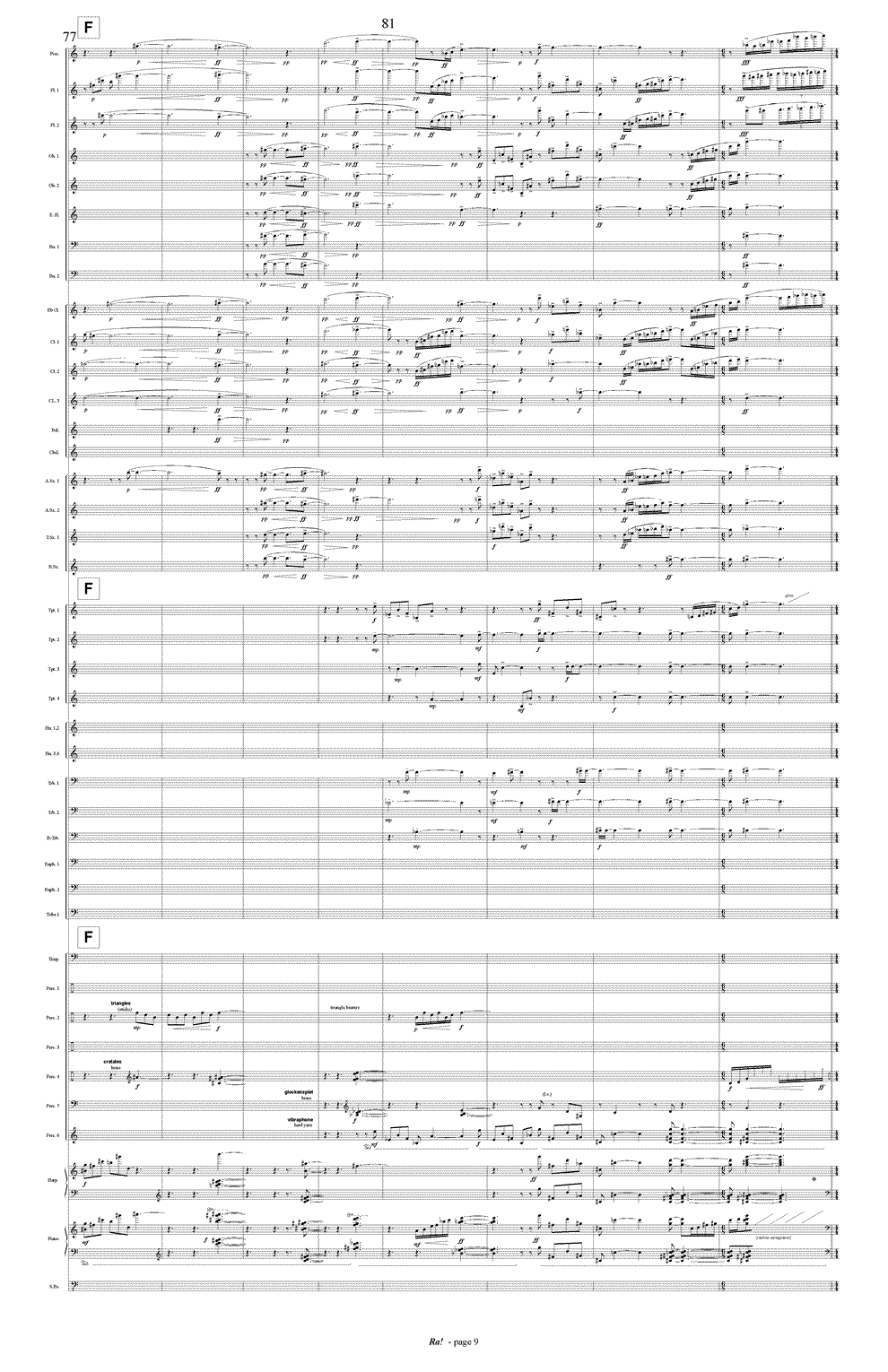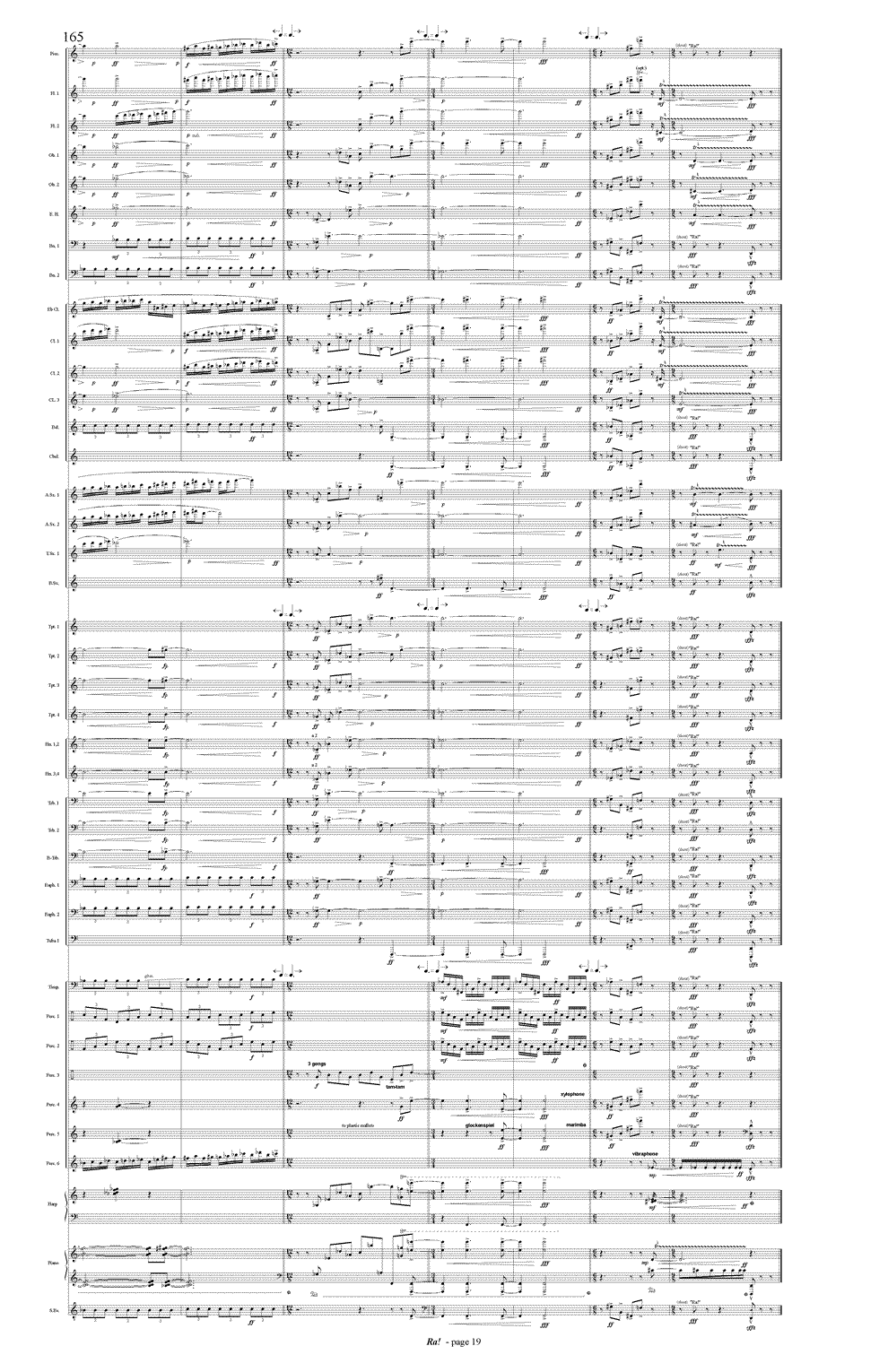Ra!
for orchestra (1997) or wind ensemble (2002)
instrumentation: orchestra band
duration: 5 minutes
orchestral premiere:
Minnesota Orchestra, Eiji Oue, March 23, 1997 (as part of sun moon stars rain)
National Symphony Orchestra of Ireland, Richard Pittman, April 1999 (Ra! by itself)
recent: Boston Symphony Orchestra, Thomas Wilkins, March 27-30, 2019
wind ensemble premiere:
Indiana University Wind Ensemble, Ray Cramer, CBDNA National Convention in Minneapolis on March 29, 2003.
orchestra:
wind ensemble:
Program Note
The sun god Ra was the most important god of the ancient Egyptians. Born anew each day, Ra journeyed across the sky in a boat crewed by many other gods. During the day Ra would do battle with his chief enemy, a serpent named Apep, usually emerging victorious, though on stormy days or during an eclipse, the Egyptians believed that Apep had won and swallowed the sun.
Ra! is a rather aggressive depiction of an imagined ritual of sun worship, perhaps celebrating the daily battles of Ra and Apep. There are four ideas presented in the movement: 1) a "skin dance" featuring the timpani and other percussion, 2) a declarative, unison melodic line, 3) a layered texture of pulses, and 4) sunbursts and shines. The movement alternates abruptly between these ideas, as if following the precise dictates of a grand ceremony.
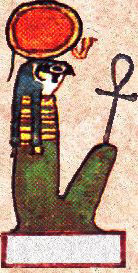
Perusal Scores
Recordings

University of North Texas Wind Symphony, Eugene Corporon
Voices of Change (Maria Schleuning, Jo Boatright)
 Innova 634 American Midlife
Innova 634 American Midlife
Slovak Radio Symphony Orchestra, David Dzubay
The following article appears in the May 2004 issue of the Journal of the National Band Association:
Ra! (2002) by David Dzubay
Duration: 5 minutes
Introduction:
I took a few piano lessons from my mother when I was 6, learned Blowin’ in the Wind on guitar in 4 th grade, and switched to violin in 5 th grade (that only lasted two weeks – I didn’t like that they would not let us sit down while playing), but when my uncle John gave me a cornet in the summer of 1974 in Wisconsin, I was hooked. I played Three Blind Mice in the VW bus all the way back to Portland, Oregon. And then in an amazing act of patience, my parents let me keep playing the cornet, eventually buying me a trumpet in 7 th grade. Some of my most important years learning about the magic of music and music making were at Jefferson High School in Portland, where I played trumpet in the various bands and chamber groups. Ok, the focus there was mostly on the jazz ensembles, but we had a very good concert band as well (playing Nelhybel, Holst, Nelson, Reed, Grainger, all that good stuff…), and then there were the various regional band and music-camp band experiences, all of which fueled my interest in the wonderful sonic possibilities of the wind ensemble. I thought, what a colorful group of instruments, capable of such a variety of sound, much more interesting than an orchestra!
I eventually grew to appreciate the possibilities of the orchestra, and have composed a great deal of orchestral music over the years, but in a way, I have returned to my musical roots in the past six years, composing five works for wind ensemble, with another planned for later this year. I am especially pleased and honored that Ra!, one of these recent pieces, has been chosen as a winner of the distinguished William D. Revelli Memorial Composition Contest by the National Band Association.
Program Note:
The sun god Ra was the most important god of the ancient Egyptians. Born anew each day, Ra journeyed across the sky in a boat crewed by many other gods. During the day Ra would do battle with his chief enemy, a serpent named Apep, usually emerging victorious, though on stormy days or during an eclipse, the Egyptians believed that Apep had won and swallowed the sun.
Ra! is a rather aggressive depiction of an imagined ritual of sun worship, perhaps celebrating the daily battles of Ra and Apep. There are four ideas presented in the movement: 1) a "skin dance" featuring the timpani and other percussion, 2) a declarative, unison melodic line, 3) a layered texture of pulses, and 4) sun bursts and shines. The movement alternates abruptly between these ideas, as if following the precise dictates of a grand ceremony.
Form Analysis:
The four distinct musical ideas in Ra!, listed in the order of first appearance:
A. "skin dance" : tutti music in compound meter with prominent tom-tom and timpani doubling of an arpeggiated ostinato in the bass instruments accompanying dramatic melodic development in the treble instruments.
B. "unison fanfare" : a declarative line, in speech-like rhythm, functioning like a pronouncement from the master of ceremonies to move on to the next event; the first statement for brass alone, the last for the entire band.
C. "layered pulses" : contrasts music A with simple meter but at the same tempo – a texture of pulsed eighths, quarters, and more complex articulations such as the ‘chimes’ for gong, vibraphone, harp, and piano at measure 35. Each chime phrase consists of four equally spaced articulations, effectively presenting a separate tempo (For example, at mm. 39-40 and 43-44).
D. “sun bursts” :dramatic outbursts from individual sections of the band, with timbrel modulations and extreme contrasts in color, register and orchestration. Pulse is rather suspended in this music.
If we divide up the total time for the movement into 10 parts, the time is divided up as follows: A=4, B=1, C=3, D=2. Further, each of these musical ideas is divided into four presentations, which also follow the proportion of 1:2:3:4, but with different orders for each. The following diagram illustrates this use of proportion. Note that for consistency, a ‘beat’ is meant to be one pulse at the prevailing tempo. So, for instance, the 3/2 bars in music A are counted as four beats, not three, as the dominant pulse is the dotted quarter.
PROPORTION DIAGRAM:
music |
Statement 1 |
Statement 2 |
Statement 3 |
Statement 4 |
Total beats (seconds) |
A
|
92 (beats) 4 (ratio) |
69 3 |
45 2 |
23 1 |
229 (100”) 4 |
B
|
12 2 |
6 1 |
17 3 |
23 4 |
58 (25”) 1 |
C
|
52 3 |
69 4 |
17 1 |
34 2 |
172 (75”) 3 |
D
|
12 1 |
23 2 |
46 4 |
36 3 |
117 (51”) 2 |
The “seconds” in the last column assume the given tempo of 138, but of course, the proportions stay the same whatever the tempo. As an aside, this useful equation determines the number of seconds in a span of music:
duration (seconds) = 60 * |
# of beats |
tempo |
Another form of that equation:
# of beats = tempo * |
duration (seconds) |
60 |
The ratios are also used to delineate form in the piece, with another unique ordering (3:4:2:1), and with each of the four large sections of the work beginning with a presentation of music A.
FORM DIAGRAM:
measure |
1 |
54 |
124 |
152 |
music |
A1 B1 C1 B2 D1 |
A2 D2 C2 B3 C3 D3 |
A3 C4 B4 |
A4 D4 |
ratio |
3 |
4 |
2 |
1 |
Hopefully, all of this proportional planning leads to concrete musical results. The longer musical ideas, A and C, are relatively stable, with a clear sense of pulse, and textures approximating melody and accompaniment. Ideas B and D are less stable, less grounded passages presented in short outbursts for the most part. As Ra! progresses, presentations of the more stable music (A, C) get shorter, and presentations of the less stable music (B, D) get longer, taking over and creating an increasing tension in the work, providing direction and helping build momentum toward the end of the piece.
The more art is controlled, limited, worked over, the more it is free. …
The more constraints one imposes,
the more one frees one's self of the chains that shackle the spirit. (I. Stravinsky)
In his Poetics of Music, Stravinsky has a wonderful discussion of freedom and the need for composers to establish restrictions and constraints in their work in order to allow them to be free to create music. Certainly in Ra!, I have imposed rather dramatic restraints as far as the form goes. This approach seemed appropriate for a composition depicting an imagined ritual following a very precise set of rules, with abrupt alternations of music and no transitions. I began work on the piece by composing fragments of each idea, then worked out the formal plan and composed my way through from beginning to end. The only real constraint was the duration of each section – within those sections I worked by intuition. Indeed, narrowly limiting my field of action did free me to compose Ra! without losing myself in the abyss of freedom.
Suggestions for Performance:
Tempo . The indicated tempo is 138, and this is what I have in mind as an ideal; however, a tempo somewhere in the range of 126-138 can work fine. In some cases 126 might work better than 138. Factors that could affect this include the acoustic environment and the size of the ensemble.
Dynamics. Players should be sure to convey to the audience all expressive dynamics, especially markings of fp, or the many dramatic hairpins, like the crescendo/diminuendo at bars 19-20 in the woodwinds, which is simultaneous with the diminuendo/crescendo in the horns. Particularly in the D music, first heard at bars 51-53, dynamics need to be followed and probably exaggerated in order to project the expression to the audience effectively.
Trills at m. 54. Each player should trill to both notes in parentheses, creating a wild and somewhat unstable sound.
“Ra!” For the shout in the last bar, directors should feel free to adjust how many players are playing or shouting. For example, depending on the size of the band and again the acoustics, it may work to have some of the instruments with written trills NOT trill and join the shout, which should be very loud, guttural, a bit rough, not clean and tidy.
First Performances, Recording, Publisher:
The first performance of Ra! was given by Ray Cramer and the Indiana University Wind Ensemble on March 29, 2003 at the CBDNA National Convention in Minneapolis. I have been incredibly fortunate to have had Ray Cramer premiere four of my works for wind band.
Ra! was shortly thereafter performed and recorded for CD by Eugene Corporon and the University of North Texas Wind Symphony and was released in fall 2003 on the Klavier label ( K11137 - Hemispheres ). This is the second work of mine released on CD in a top quality recording by Eugene Corporon and the UNT Wind Symphony, the first being Myaku (K11110).
Like an increasing number of composers today, I am now self-published. Though a few early works can be found with Thompson Edition (some brass music) and Dorn (a saxophone quartet), almost all of my music is now published by my BMI-affiliated company, PRO NOVA MUSIC , the web site for which can be found by a ‘Google’ search of either my name or the company name, or by directing your browser to:
Scores and sets of parts are available for sale through Pro Nova Music . Scores are $35 and full sets of parts are $175. From experience with my earlier works for wind ensemble, I realize it works better for bands to buy music than to rent it. My former (un-named) publisher, like so many publishers, was basically only interested in renting music. I am interested in facilitating performances, so have made the music available on a for-sale basis.
Ra! Is the fourth of five works I have composed for wind ensemble, the others being Myaku (1999, 5 minutes), …as filaments of memory spin…(1998, 10 minutes), Incantation (1991, 9 minutes), and I work composed last summer, Fanfares on Re for Ray (2003, 7 minutes), which was commissioned by the family of Ray Cramer in celebration of his career at the Indiana University School of Music, from which he will be retiring in May of 2005. A project I have coming up this summer is the composition of a 12-15 minute work commissioned by the Metropolitan Wind Symphony of Boston, for premiere in 2005.
David Dzubay
Professor of Music Composition, Chair
Director, IU New Music Ensemble
Indiana University School of Music
ddzubay@indiana.edu
 Instrumentation: Orchestra
Instrumentation: Orchestra
3 Flutes (3 rd doubling piccolo)
2 Oboes
English Horn
2 Bb Clarinets
Bb Bass Clarinet / Bb Contrabass Clarinet (optional)
2 Bassoons
Contrabassoon
4 Horns in F
3 Trumpets in C
2 Tenor Trombones
Bass Trombone
Tuba
Timpani
4 Percussion:
1: Glockenspiel, Medium Suspended Symbal, 3 Gongs, Tam-tam (large), Marimba
2: Vibraphone, Medium Splash Cymbal, Roto-toms
3: 3 Triangles, Small and Large Suspended Cymbals, 4 Tom-toms
4: Crotales, Small Splash Cymbal, Cowbell, Xylophone, Bass Drum
Harp
Celesta
Piano
Strings
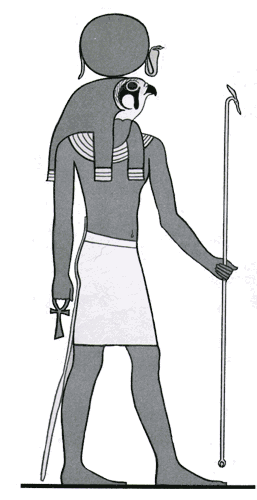 Instrumentation: Wind Ensemble
Instrumentation: Wind Ensemble
Piccolo
Flute 1, 2
Oboe 1, 2
English Horn
Bassoon 1, 2
Eb Clarinet
Bb Clarinet 1, 2, 3
Bb Bass Clarinet
Bb Contrabass Clarinet (or, Eb Contra Alto Clarinet)
Eb Alto Saxophone 1, 2
Bb Tenor Saxophone
Eb Baritone Saxophone
Bb Trumpet 1, 2, 3, 4
F Horn 1, 2, 3, 4
Trombone 1, 2
Bass Trombone
Euphonium 1, 2
Tuba 1, 2
Timpani
6 Percussion:
1: splash cymbal (med.), 5 roto-toms
2: suspended cymbals (med., lg.), 4 tom-toms
3: 3 graduated triangles, 3 graduated gongs, suspended cymbal (sm.), tam-tam
4: xylophone, crotales (2 octaves), splash cymbal (sm.), cowbell, bass drum
5: glockenspiel, marimba
6: vibraphone, marimba
Harp (optional)
Piano (optional)
String Bass (optional)



